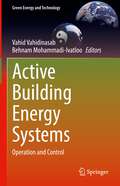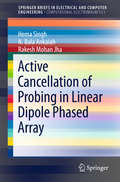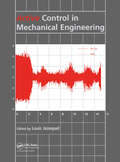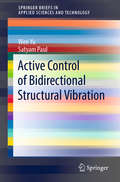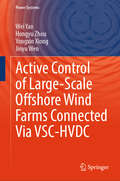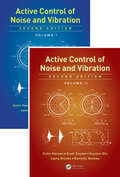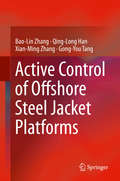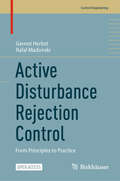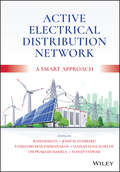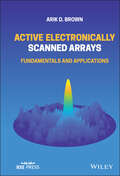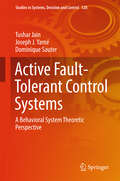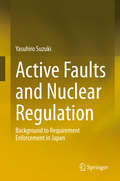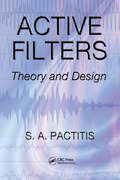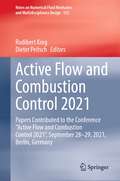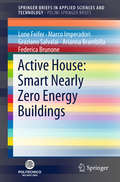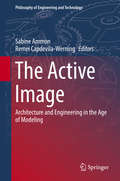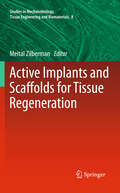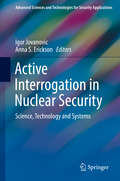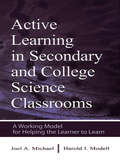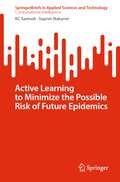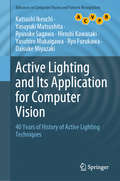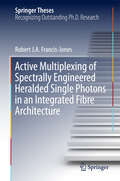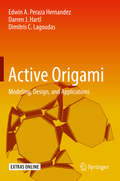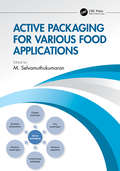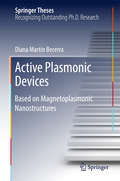- Table View
- List View
Active Building Energy Systems: Operation and Control (Green Energy and Technology)
by Vahid Vahidinasab Behnam Mohammadi-IvatlooThis book provides a comprehensive study on state-of-the-art developments in the control, operation, and market participation of active buildings (ABs). Active buildings can support the broader energy system by intelligent integration of renewable-based energy technologies for heating, cooling, electricity, and transport. This important reference analyzes the key features of modern control and operation techniques applied to these systems. Contributions from an international team of experts present practical methods with evidence and case studies from applications to real-world or simulated active buildings. Sample computer codes and analytical examples aid in the understanding of the presented methods. The book will support researchers working on the control and operation of buildings as an energy system, smart cities and smart grids, and microgrids, as well as researchers and developers from the building and energy engineering, economic, and operation research fields.Provides an in-depth review of building-level energy systems technologies;Covers codes, standards, and requirements for active building control systems;Includes sample computer code and analytical examples.
Active Cancellation of Probing in Linear Dipole Phased Array (SpringerBriefs in Electrical and Computer Engineering)
by Hema Singh Rakesh Mohan Jha N. Bala AnkaiahIn this book, a modified improved LMS algorithm is employed for weight adaptation of dipole array for the generation of beam pattern in multiple signal environments. In phased arrays, the generation of adapted pattern according to the signal scenario requires an efficient adaptive algorithm. The antenna array is expected to maintain sufficient gain towards each of the desired source while at the same time suppress the probing sources. This cancels the signal transmission towards each of the hostile probing sources leading to active cancellation. In the book, the performance of dipole phased array is demonstrated in terms of fast convergence, output noise power and output signal-to-interference-and noise ratio. The mutual coupling effect and role of edge elements are taken into account. It is established that dipole array along with an efficient algorithm is able to maintain multilobe beamforming with accurate and deep nulls towards each probing source. This work has application to the active radar cross section (RCS) reduction. This book consists of formulation, algorithm description and result discussion on active cancellation of hostile probing sources in phased antenna array. It includes numerous illustrations demonstrating the theme of the book for different signal environments and array configurations. The concepts in this book are discussed in an easy-to-understand manner, making it suitable even for the beginners in the field of phased arrays and adaptive array processing.
Active Control in Mechanical Engineering: Proceedings of the MV2 Convention on Active Control in Mechanical Engineering, Lyon, France, 22-23 October 1997.
by Louis JezequelThe introduction of active control in structural dynamics has led to a number of developments over wide-ranging industrial domains. This work investigates this area and examines a number of topics including: smart materials and structures; new strategies of active control and its applications.
Active Control of Bidirectional Structural Vibration (SpringerBriefs in Applied Sciences and Technology)
by Wen Yu Satyam PaulThis book focuses on safeguarding civil structures and residents from natural hazards such as earthquakes through the use of active control. It proposes novel proportional-derivative (PD) and proportional-integral-derivative (PID) controllers, as well as discrete-time sliding mode controllers (DSMCs) for the vibration control of structures involving nonlinearities. Fuzzy logic techniques are used to compensate for nonlinearities. The first part of the book addresses modelling and feedback control in inelastic structures and presents a design for PD/PID controllers. In the second part, classical PD/PID and type-2 fuzzy control techniques are combined to compensate for uncertainties in the structures of buildings. The methodology for tuning the gains of PD/PID is obtained using Lyapunov stability theory, and the system’s stability is verified. Lastly, the book puts forward a DSMC design that does not require system parameters, allowing it to be more flexibly applied. All program codes used in the paper are presented in a MATLAB®/Simulink® environment. Given its scope, the book will be of interest to mechanical and civil engineers, and to advanced undergraduate and graduate engineering students in the areas of structural engineering, structural vibration, and advanced control.
Active Control of Large-Scale Offshore Wind Farms Connected Via VSC-HVDC (Power Systems)
by Wei Yao Hongyu Zhou Yongxin Xiong Jinyu WenThis book provides a detailed study of the active control methods for large-scale offshore wind farms connected via flexible high-voltage direct current (VSC-HVDC) transmission systems. Firstly, it introduces the basic structure and fundamental control of offshore wind farms connected via VSC-HVDC systems, and proposes a vector modeling method for them. Furthermore, it analyzes the fault characteristics of offshore wind farms connected via VSC-HVDC systems under different fault conditions, and proposes an active fault suppression method based on energy control. Finally, it introduces the method of offshore wind farms connected via VSC-HVDC systems to support the grid frequency. From basic concepts to self-active safety control, and then to active support control of the grid, this book systematically introduces the active control methods of large-scale offshore wind farms connected via VSC-HVDC systems. In particular, it introduces some advanced control methods from the perspective of energy. This book is a useful reference for undergraduate and graduate students interested in offshore wind farms and VSC-HVDC, researchers studying fault ride-through and active frequency support of offshore wind farms connected via VSC-HVDC systems, as well as engineers.
Active Control of Noise and Vibration
by Scott Snyder Colin Hansen Danielle Moreau Xiaojun Qiu Laura BrooksIntegrating active control of both sound and vibration, this comprehensive two-volume set combines coverage of fundamental principles with the most recent theoretical and practical developments. The authors explain how to design and implement successful active control systems in practice and detail the pitfalls one must avoid to ensure a reliable and stable system. Extensively revised, updated, and expanded throughout, the second edition reflects the advances that have been made in algorithms, DSP hardware, and applications since the publication of the first edition.
Active Control of Offshore Steel Jacket Platforms
by Gong-You Tang Xian-Ming Zhang Qing-Long Han Bao-Lin Zhang<p>Offshore platforms are widely used to explore, drill, produce, store and transport ocean resources, and are usually subjected to environmental loading, which can lead to deck facility failure and platform fatigue failure, inefficient operation and even crew discomfort. In order to ensure the reliability and safety of offshore platforms, it is important to explore effective ways of suppressing the vibration of offshore platforms. <p>This book provides a brief overview of passive, semi-active and active control schemes to deal with vibration of offshore platforms. It then comprehensively and systematically discusses the recent advances in active systems with optimal, sliding model, delayed feedback and network-based control. Intended for readers interested in vibration control and ocean engineering, it is particularly useful for researchers, engineers, and graduate students in the fields of system and control community, vibration control, ocean engineering, as well as electrical and electronic engineering.</p>
Active Disturbance Rejection Control: From Principles to Practice (Control Engineering)
by Gernot Herbst Rafal MadonskiThis open access text offers the first comprehensive introduction to the fundamental principles and practical implementation of Active Disturbance Rejection Control (ADRC). Drawing on their years of experience in both research and industry, the authors have designed the text to be accessible to readers at any level of knowledge and experience with ADRC. Multiple entry points and paths through the text are defined so that it can be easily adapted to their specific needs. Part I covers the theoretical foundations of ADRC, giving readers the basic information in a self-contained, tutorial style. Emphasis is placed on first developing an intuition for ADRC through illustrative examples inspired by real control problems. The main concepts are then introduced and explored in a more formal and concise manner using standard control-domain-related terminology. Part II demonstrates methods for applying ADRC in practice through software-based implementation. Utilizing laboratory testbeds to mimic real control problems from process and control areas, the authors illustrate the use of software through both model-based environments - including MATLAB/Simulink - and low-level C programming language. Common issues that one can encounter when implementing controllers in the real world are also examined, and specific solutions to these problems are offered that retain the simplicity of ADRC. This book can be used as a textbook, handbook, or reference manual, and through its many entry points, can be easily picked up by students, practitioners, and scientists. Having in mind its introductory nature, the prerequisites for studying the considered subject are intentionally not very strict. Readers should have at least basic knowledge of systems and controls, as well as an understanding of core mathematical concepts of calculus, linear algebra, and differential equations.
Active Electrical Distribution Network: A Smart Approach
by Baseem Khan Josep M. Guerrero Sanjeevikumar Padmanaban Hassan Haes Alhelou Om Prakash Mahela Sudeep TanwarACTIVE ELECTRICAL DISTRIBUTION NETWORK Discover the major issues, solutions, techniques, and applications of active electrical distribution networks with this edited resourceActive Electrical Distribution Network: A Smart Approach delivers a comprehensive and insightful guide dedicated to addressing the major issues affecting an often-overlooked sector of the electrical industry: electrical distribution. The book discusses in detail a variety of challenges facing the smart electrical distribution network and presents a detailed framework to address these challenges with renewable energy integration.The book offers readers fulsome analyses of active distribution networks for smart grids, as well as active control approached for distributed generation, electric vehicle technology, smart metering systems, smart monitoring devices, smart management systems, and various storage systems. It provides a treatment of the analysis, modeling, and implementation of active electrical distribution systems and an exploration of the ways professionals and researchers from academia and industry attempt to meet the significant challenges facing them.From smart home energy management systems to approaches for the reconfiguration of active distribution networks with renewable energy integration, readers will also enjoy:A thorough introduction to electrical distribution networks, including conventional and smart networksAn exploration of various existing issues related to the electrical distribution networkAn examination of the importance of harmonics mitigation in smart distribution networks, including active filtersA treatment of reactive power compensation under smart distribution networks, including techniques like capacitor banks and smart devicesAn analysis of smart distribution network reliability assessment and enhancementPerfect for professionals, scientists, technologists, developers, designers, and researchers in smart grid technologies, security, and information technology, Active Electrical Distribution Network: A Smart Approach will also earn a place in the libraries of policy and administration professionals, as well as those involved with electric utilities, electric policy development, and regulating authorities.
Active Electronically Scanned Arrays: Fundamentals and Applications (IEEE Press)
by Arik D. BrownIn Active Electronically Scanned Arrays: Fundamentals and Applications, electromagnetics expert Dr. Arik D. Brown delivers a foundational treatment of active electronically scanned arrays (AESAs) ideal for engineering students and professionals. The distinguished author provides an overview of the primary subsystems of an AESA and detailed explanations of key design concepts and fundamentals for subsystems, including antenna array elements, transmit/receive modules, and beamformers. Performance results for various AESA architectures often found in industry, including analog, subarrayed, and digital beamforming AESAs, are discussed. With a focus on practical knowledge and applications, Active Electronically Scanned Arrays: Fundamentals and Applications offers an accessible overview of a technology critical to the implementation of collision avoidance in cars, air surveillance radar, communication antennas, and defense technologies. The book also includes: A thorough introduction to AESAs, including a top-level block diagram view and explanations of key components and subsystems Detailed explanations of the impact of AESAs on mission applications including Radar, Electronic Attack (EA), Electronic Support Measures (ESM), SIGINT and Communications Comprehensive explorations of antenna array elements, transmit/receive modules, and beamformers including their purpose, functions, and practical design considerations In-depth examinations of AESA architecture performance for current and future systems Utility of AESAs for implementing adaptive beamforming for Electronic Counter-Countermeasures (ECCM) Perfect for electrical engineers working with active electronically scanned arrays, electronic warfare technologies, radar, or communications, Active Electronically Scanned Arrays: Fundamentals and Applications will also prove to be an invaluable resource for defense students undertaking military education and training.
Active Fault-Tolerant Control Systems: A Behavioral System Theoretic Perspective (Studies in Systems, Decision and Control #128)
by Tushar Jain Joseph J. Yamé Dominique SauterThe book introduces novel algorithms for designing fault-tolerant control (FTC) systems using the behavioral system theoretic approach, and presents a demonstration of successful novel FTC mechanisms on several benchmark examples. The authors also discuss a new transient management scheme, which is an essential requirement for the implementation of active FTC systems, and two data-driven methodologies that are broadly classified as active FTC systems: the projection-based approach and the online-redesign approach. These algorithms do not require much a priori information about the plant in real-time, and in addition this novel implementation of active FTC systems circumvents various weaknesses induced by using a diagnostic module in real-time. The book provides graduate students taking masters and doctoral courses in mathematics, control, and electrical engineering an excellent stepping-stone for their research. It also appeals to practitioners interested to apply innovative fail-safe control techniques.
Active Faults and Nuclear Regulation: Background to Requirement Enforcement in Japan
by Yasuhiro SuzukiThis book reviews the active faults around nuclear power plants in Japan and recommends an optimal method of nuclear power regulation controlled by the Nuclear Regulation Authority of Japan. The active faults around nuclear power plants have been underestimated in Japan since the latter half of the 20th century. However, based on the lessons learned from the Fukushima nuclear power plant accident, the book sheds light on why the risks of active faults were underestimated, and discusses the optimal scientific method of assessing those risks. Further, the author shares his experiences in the new standard for nuclear regulation creation team and in the active fault survey at the Nuclear Regulation Authority of Japan. This book is a valuable resource for students, researchers, academic and policy-makers, as well as non-experts interested in nuclear safety.
Active Filters: Theory and Design
by S.A. PactitisUsing an accessible yet rigorous approach, Active Filters: Theory and Design highlights the essential role of filters, especially analog active filters, in applications for seismology, brainwave research, speech and hearing studies, and other medical electronics. The book demonstrates how to design filters capable of meeting a given set of specifications. Recognizing that circuit simulation by computer has become an indispensable verification tool both in analysis and in design, the author emphasizes the use of MicroCap for rapid test of the filter. He uses three basic filter types throughout the book: Butterworth, Chenyshev, and Bessel. These three types of filters are implemented with the Sallen-Key, infinite gain multiple feedback, state-variable, and biquad circuits that yield low-pass, high-pass, band-pass, and band-reject circuits. The book illustrates many examples of low-pass, high-pass, band-pass, and notch active filters in complete detail, including frequency normalizing and denormalizing techniques. Design equations in each chapter provide students with a thorough grounding in how to implement designs. This detailed theoretical treatment gives you the tools to teach your students how to master filter design and analysis.
Active Flow and Combustion Control 2021: Papers Contributed to the Conference “Active Flow and Combustion Control 2021”, September 28–29, 2021, Berlin, Germany (Notes on Numerical Fluid Mechanics and Multidisciplinary Design #152)
by Rudibert King Dieter PeitschThe book reports on the latest theoretical and experimental findings in the field of active flow and combustion control, in the context of energy conversion for power and propulsion systems. It covers new developments in actuator technology and sensing, robust and optimal open- and closed-loop control, model reduction for control purposes, and unsteady turbine cooling and performance, among other relevant topics. Gathering contributions to the Active Flow and Combustion Control (AFCC 2021), held virtually on September 28-29, 2021, from the Technische Universität Berlin, Germany, this book describes research that has been carried out within, and supported by, the collaborative research center SFB 1029 on “Substantial efficiency increase in gas turbines through direct use of coupled unsteady combustion and flow dynamics”, and funded by the German Research Foundation (DFG). It highlights theoretical and practical aspects, and corresponding solutions, that are important for the development of future energy conversion systems, thus offering a timely guide for researchers and practitioners in the field of aeronautics, turbomachinery, control and combustion.
Active House: Smart Nearly Zero Energy Buildings (SpringerBriefs in Applied Sciences and Technology)
by Lone Feifer Marco Imperadori Graziano Salvalai Arianna Brambilla Federica BrunoneThe book provides an overview of the Active House (AH) vision, intended as a building design method “beyond” the passive approach for buildings of the future that will be more and more connected, smart and innovative. It offers a novel philosophical design approach in which buildings, new or renovated, are in balance with natural, renewable energies and become “concentrators-distributors” of energies instead of being consumers of resources. The book is composed of five chapters, providing information on fundamental aspects of innovations toward resource-efficient buildings, as well as case studies presenting the concept in practice. It demonstrates that a completely new design approach is possible, and that a turning point has been reached. Lastly, it shows how the AH Alliance, along with designers, institutions, industries and academies, is bringing a breath of fresh air to the world of construction.
The Active Image
by Sabine Ammon Remei Capdevila-WerningThe "active image" refers to the operative nature of images, thus capturing the vast array of "actions" that images perform. This volume features essays that present a new approach to image theory. It explores the many ways images become active in architecture and engineering design processes and how, in the age of computer-based modeling, images play an indispensable role. The contributors examine different types of images, be they pictures, sketches, renderings, maps, plans, and photographs; be they analog or digital, planar or three-dimensional, ephemeral, realistic or imaginary. Their essays investigate how images serve as means of representing, as tools for thinking and reasoning, as ways of imagining the inexistent, as means of communicating and conveying information and how images may also perform functions and have an agency in their own. The essays discuss the role of images from the perspective of philosophy, theory and history of architecture, history of science, media theory, cognitive sciences, design studies, and visual studies, offering a multidisciplinary approach to imagery and showing the various methodologies and interpretations in current research. In addition, they offer valuable insight to better understand how images operate and function in the arts and sciences in general.
Active Implants and Scaffolds for Tissue Regeneration (Studies in Mechanobiology, Tissue Engineering and Biomaterials #8)
by Meital ZilbermanActive implants are actually drug or protein-eluting implants that induce healing effects, in addition to their regular task, such as support. This effect is achieved by controlled release of the active agent to the surrounding tissue. This book will give a broad overview of biomaterial platforms used as basic elements of drug-eluting implants. It will include mainly coatings for vascular stents with controlled release of antiproliferative agents, wound dressings with controlled release of antibacterial agents, drug-eluting vascular grafts, protein-eluting scaffolds for tissue regeneration, drug-eluting platforms for dental and other applications. Thus, both internal and external implants are described. The drug-eluting implants will be described in terms of matrix formats and polymers, incorporated drugs and their release profiles from the implants, as well as implant functioning. Smart polymeric systems, such as crosslinked poly-lactones, thermo and pH-sensitive hydrogels and poly(amido-amines), as well as novel basic structural elements, such as composite fibers and films, and nanostructures will be thoroughly described. The effect of the processing parameters on the microstructure and on the resulting drug release profiles, mechanical and physical properties, and other relevant properties, will be emphasized. The described new biomaterials approaches for active implants enhance the tools available for creating clinically important biomedical applications.
Active Interrogation in Nuclear Security: Science, Technology and Systems (Advanced Sciences and Technologies for Security Applications)
by Igor Jovanovic Anna S. EricksonThis volume constitutes the state-of-the-art in active interrogation, widely recognized as indispensable methods for addressing current and future nuclear security needs. Written by a leading group of science and technology experts, this comprehensive reference presents technologies and systems in the context of the fundamental physics challenges and practical requirements. It compares the features, limitations, technologies, and impact of passive and active measurement techniques; describes radiation sources for active interrogation including electron and ion accelerators, intense lasers, and radioisotope-based sources; and it describes radiation detectors used for active interrogation. Entire chapters are devoted to data acquisition and processing systems, modeling and simulation, data interpretation and algorithms, and a survey of working active measurement systems. Active Interrogation in Nuclear Security is structured to appeal to a range of audiences, including graduate students, active researchers in the field, and policy analysts.The first book devoted entirely to active interrogationPresents a focused review of the relevant physicsSurveys available technologyAnalyzes scientific and technology trends Provides historical and policy context Igor Jovanovic is a Professor of Nuclear Engineering and Radiological Sciences at the University of Michigan and has previously also taught at Penn State University and Purdue University. He received his Ph.D. from University of California, Berkeley and worked as physicist at Lawrence Livermore National Laboratory. Dr. Jovanovic has made numerous contributions to the science and technology of radiation detection, as well as the radiation sources for use in active interrogation in nuclear security. He has taught numerous undergraduate and graduate courses in areas that include radiation detection, nuclear physics, and nuclear security. At University of Michigan Dr. Jovanovic is the director of Neutron Science Laboratory and is also associated with the Center for Ultrafast Optical Science. Anna Erickson is an Assistant Professor in the Nuclear and Radiological Engineering Program of the G.W. Woodruff School of Mechanical Engineering at Georgia Institute of Technology. Previously, she was a postdoctoral researcher in the Advanced Detectors Group at Lawrence Livermore National Laboratory. Dr. Erickson received her PhD from Massachusetts Institute of Technology with a focus on radiation detection for active interrogation applications. Her research interests focus on nuclear non-proliferation including antineutrino analysis and non-traditional detector design and characterization. She teaches courses in advanced experimental detection for reactor and nuclear nonproliferation applications, radiation dosimetry and fast reactor analysis.
Active Learning in Secondary and College Science Classrooms: A Working Model for Helping the Learner To Learn
by Joel Michael Harold I. ModellThe working model for "helping the learner to learn" presented in this book is relevant to any teaching context, but the focus here is on teaching in secondary and college science classrooms.Specifically, the goals of the text are to: *help secondary- and college-level science faculty examine and redefine their roles in the classroom; *define for science teachers a framework for thinking about active learning and the creation of an active learning environment; and *provide them with the assistance they need to begin building successful active learning environments in their classrooms. Active Learning in Secondary and College Science Classrooms: A Working Model for Helping the Learner to Learn is motivated by fundamental changes in education in response to perceptions that students are not adequately acquiring the knowledge and skills necessary to meet current educational and economic goals. The premise of this book is that active learning offers a highly effective approach to meeting the mandate for increased student knowledge, skills, and performance. It is a valuable resource for all teacher trainers in science education and high school and college science teachers.
Active Learning to Minimize the Possible Risk of Future Epidemics (SpringerBriefs in Applied Sciences and Technology)
by KC Santosh Suprim NakarmiFuture epidemics are inevitable, and it takes months and even years to collect fully annotated data. The sheer magnitude of data required for machine learning algorithms, spanning both shallow and deep structures, raises a fundamental question: how big data is big enough to effectively tackle future epidemics? In this context, active learning, often referred to as human or expert-in-the-loop learning, becomes imperative, enabling machines to commence learning from day one with minimal labeled data. In unsupervised learning, the focus shifts toward constructing advanced machine learning models like deep structured networks that autonomously learn over time, with human or expert intervention only when errors occur and for limited data—a process we term mentoring. In the context of Covid-19, this book explores the use of deep features to classify data into two clusters (0/1: Covid-19/non-Covid-19) across three distinct datasets: cough sound, Computed Tomography (CT) scan, and chest x-ray (CXR). Not to be confused, our primary objective is to provide a strong assertion on how active learning could potentially be used to predict disease from any upcoming epidemics. Upon request (education/training purpose), GitHub source codes are provided.
Active Lighting and Its Application for Computer Vision: 40 Years of History of Active Lighting Techniques (Advances in Computer Vision and Pattern Recognition)
by Katsushi Ikeuchi Yasuyuki Matsushita Ryusuke Sagawa Hiroshi Kawasaki Yasuhiro Mukaigawa Ryo Furukawa Daisuke MiyazakiThis book describes active illumination techniques in computer vision. We can classify computer vision techniques into two classes: passive and active techniques. Passive techniques observe the scene statically and analyse it as is. Active techniques give the scene some actions and try to facilitate the analysis. In particular, active illumination techniques project specific light, for which the characteristics are known beforehand, to a target scene to enable stable and accurate analysis of the scene. Traditional passive techniques have a fundamental limitation. The external world surrounding us is three-dimensional; the image projected on a retina or an imaging device is two-dimensional. That is, reduction of one dimension has occurred. Active illumination techniques compensate for the dimensional reduction by actively controlling the illumination. The demand for reliable vision sensors is rapidly increasing in many application areas, such as robotics and medical image analysis. This book explains this new endeavour to explore the augmentation of reduced dimensions in computer vision. This book consists of three parts: basic concepts, techniques, and applications. The first part explains the basic concepts for understanding active illumination techniques. In particular, the basic concepts of optics are explained so that researchers and engineers outside the field can understand the later chapters. The second part explains currently available active illumination techniques, covering many techniques developed by the authors. The final part shows how such active illumination techniques can be applied to various domains, describing the issue to be overcome by active illumination techniques and the advantages of using these techniques. This book is primarily aimed at 4th year undergraduate and 1st year graduate students, and will also help engineers from fields beyond computer vision to use active illumination techniques. Additionally, the book is suitable as course material for technical seminars.
Active Multiplexing of Spectrally Engineered Heralded Single Photons in an Integrated Fibre Architecture (Springer Theses)
by Robert J. A. Francis-JonesThis clearly written thesis discusses the development of a highly innovative single-photon source that uses active optical switching, known as multiplexing, to increase the probability of delivering photons into a single mode. Improving single-photon sources is critical in advancing the state of the art in photonic quantum technologies for information processing and communications.
Active Origami: Modeling, Design, and Applications
by Edwin A. Peraza Hernandez Darren J. Hartl Dimitris C. LagoudasOrigami structures have the ability to be easily fabricated from planar forms, enable the deployment of large structures from small volumes, and are potentially reconfigurable. These characteristics have led to an increased interest in theoretical and computational origami among engineers from across the world. In this book, the principles of origami, active materials, and solid mechanics are combined to present a full theory for origami structures. The focus is on origami structures morphed via active material actuation and formed from sheets of finite thickness. The detailed theoretical derivations and examples make this an ideal book for engineers and advanced students who aim to use origami principles to develop new applications in their field.
Active Packaging for Various Food Applications
by M. SelvamuthukumaranMicrobial attacks occur on food surfaces even when the food is packaged. This can be attributed to moisture permeability in the packaging materials and other environmental conditions. Therefore, active agents like antimicrobial components and antioxidants must be incorporated into the packaging system; these active agents function by enhancing the stability of the product to a greater extent. Implementing an active packaging system ensures the safety and quality aspects of packaged foods so that consumers may use the products without worry. Active Packaging for Various Food Applications addresses the significance of active packaging for enhancing the quality and safety of various packaged foods. This book discusses extending the shelf life of various food products by incorporating various active packaging systems. It also addresses bioactive materials used for packing food products and applications of nanomaterials in an active packaging system. Key Features: Describes the uses of active packaging materials for various food processing industries like dairy, cereals, fruits and vegetables, meat, etc. Explains the application of biosensors for the detection of spoilage of active packed food products Discusses the importance of active packaging techniques for retaining antioxidants and micro as well as macronutrients Highlights the importance of active packaging of foods and its advantages This book is a great source for academicians, scientists, research scholars, and food industry personnel because it sheds light on the recent techniques used in active packaging systems for enhancing quality aspects.
Active Plasmonic Devices: Based on Magnetoplasmonic Nanostructures (Springer Theses)
by Diana Martín BecerraThis thesis investigates the effect of the magnetic field on propagating surface plasmon polaritons (SPPs), or surface plasmons for short. Above all, it focuses on using the magnetic field as an external agent to modify the properties of the SPPs, and therefore achieving active devices. Surface plasmons are evanescent waves that arise at metal-dielectric interfaces. They can be strongly confined (beyond the light diffraction limit), and provide a strong enhancement of the electromagnetic field at the interface. These waves have led to the development of plasmonic circuitry, which is a key candidate as an alternative to electronic circuitry and traditional optical telecommunication devices, since it is faster than the former and less bulky than the latter. Adopting both a theoretical and an experimental point of view, the book analyzes the magnetic modulation in SPPs by means of an interferometer engraved in a multilayer combining Au and Co. In this interferometer, which acts like a modulator, the SPP magnetic modulation is studied in detail, as are the parameters that have a relevant impact on it, simple ways to enhance it, its spectral dependence, and the highly promising possibility of using this system for biosensing. The thesis ultimately arrives at the conclusion that this method can provide values of modulations similar to other active methods used in plasmonics.
